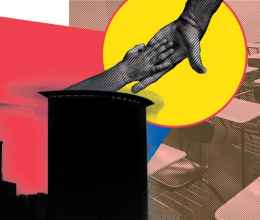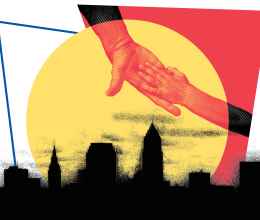Our entire electoral system is deeply related to one’s residency. Where you live determines what district you vote in, the candidates you choose to support each election, and the issues that appear on your ballot. But, can you vote if you do not have a traditional place of residence? How do you vote if you are experiencing homelessness? The answer is that those experiencing housing instability or homelessness absolutely have the right to vote, but they often face unfair and steep hurdles to exercise their constitutional right to cast a ballot.
As a social work student I’d like to offer some tips and recommendations for unhoused Ohioans who want to make their voice heard through the ballot box in the 2020 General Election.
Policy starts with voting.
Our votes place representatives in offices at all levels of governance and their decisions influence what policies are put in place. We are only a few short months out from a monumental presidential election. This election will determine the trajectory of American domestic and foreign policy for years to come; however, there are, in many ways, more local and statewide policies that could have an immediate impact for the unhoused population all across Ohio. The presidential election will dictate large scale policy around homelessness and community development, such as the appointment of the Secretary of Housing and Urban Development, but local policy can directly influence how the neighborhoods and communities that the unhoused reside in are changed. This includes decisions on whether to keep or remove public benches, limit inhabitable space, issue unconstitutional panhandling ordinances, or grow the number of parks. People experiencing homelessness, whether temporary or chronic, have a large stake in each and every election.
Step 1: Registration
Anyone experiencing homelessness who is a U.S. citizen, over the age of 18, and not currently incarcerated for a felony conviction has the right to vote. The unhoused can list a shelter they reside at as their residence for registration, this includes YMCA/YWCAs. A comprehensive list of homeless shelters in Ohio can be found at HomelessShelterDirectory.org, a list of women’s shelters in Ohio can be found at WomensShelters.org, and you can visit the YMCA website or the YWCA website to locate a nearby YMCA or YWCA. Unsheltered individuals can provide a brief description of where they reside as a form of residence. To register to vote in Ohio one must provide their driver’s license number, an Ohio identification card number, or the last four digits of their social security number. For demographics experiencing housing insecurity, we recommend you register on paper rather than online because online registration requires both driver’s license or Ohio identification number and social. Remember, voter registration ends October 5th!
How to cast your ballot:
Ohioans have three options to vote this election:
-
- Vote by mail with an absentee ballot (mail in ballot requests must be received by one’s county board of elections by October 31st),
- Early in-person voting (beginning on October 6th), or
- In-person Election Day voting on November 3rd.
To vote in person on Election Day you need a specific type of voter identification which can be challenging for unhoused people. Identification options include: a valid government ID (such as a driver’s license or state ID card, a military identification card, current utility bill, a government check or document that shows current address.
To request an absentee ballot and vote by mail or to vote early, in-person one is only required to present your driver’s license number, the last four digits of your social security number, a copy of a current and valid form of photo identification, or copy of a current utility bill. If possible, we recommend unhoused individuals vote early in person to avoid any mail delivery issues at the shelter or place of temporary residence. Voting by mail is also an option, however once an absentee ballot is requested they cannot get a second ballot sent to a different address. If an individual is recently unhoused due to any circumstance and has already had a mailed ballot application, but has no way to receive or retrieve it, their only option is to exercise a backup in person voting plan. Of note, this means one would have to cast a provisional ballot at your polling location, and your ballot will be officially cast once there is confirmation by the county board of elections that you did not also send in a vote by mail ballot
Simply getting to the county board of elections can be a great challenge for unhoused people. So, in many cases for the unhoused, problems with Election Day identification and accessibility arise. Without one of the above-mentioned valid forms of identification, an unhoused person’s best bet to vote may be to obtain a government ID card. Unfortunately, to obtain a government ID card a good deal of documentation is needed. An unhoused individual would need proof of date of birth, proof of social security number, full legal name, proof of address, and possibly proof of legal name change if they are transgender. Some of the acceptable forms of documentation for this identification card overlap with acceptable proof of voter identification. This loop of gathering difficult- to-obtain personal identification to be granted difficult-to-obtain proper voter identification in order to cast a ballot is a bureaucratic spiral creating more hurdles and suppressing the vote of the unhoused and others.
Access and Education
To top it all off, there are immense challenges for the unhoused to even access this information. It can be incredibly difficult for them to access voter registration resources. People experiencing homelessness may not even know they are eligible to vote without a permanent address or that they can list a shelter as their address. This education and outreach falls in the hands of community agencies and shelters. As a social work student, I know the importance of client self-determination. Community agencies, such as alcohol and substance abuse rehabilitation centers, free clinics, and food pantries, need to be not only voting rights literate but also in the business of proactively providing resources on voting rights. The unhoused should have their voices heard and it is the job of all of us, but especially community agencies, shelters, voting rights organizations, and social workers to facilitate their expression all the way through the voting process. This can look like running voter registration drives for unhoused clients, asking clients on intake if they wish to register to vote, providing ballot issue and candidate breakdowns at the front desk or waiting areas, offering rides to the polls, printing out absentee ballot applications, and any other ways an agency might be uniquely positioned to provide. It can even be as simple as guiding an unhoused person through the registration form if they need assistance.
Unhoused individuals have a right to vote. It can be incredibly challenging for people experiencing homelessness to cast a ballot and Ohio can and should do a lot more to ensure that ALL eligible Ohioans, despite their housing situation, can cast a safe, secure, and accessible ballot. Voter registration is hard to access and voter identification laws present unique challenges for people chronically or newly experiencing housing insecurity or homelessness. However, there are still ways for unhoused people to vote for what and who they believe in. Shelters and community agencies have a profound role to play in ensuring all unhoused voices are heard in the voting booths by November 3rd, or earlier via vote by mail or early, in-person voting.
For more general information and advocacy for the unhoused visit the Northeast Ohio Coalition for the Homeless, the Coalition on Homelessness and Housing in Ohio, and the Greater Cincinnati Homeless Coalition







